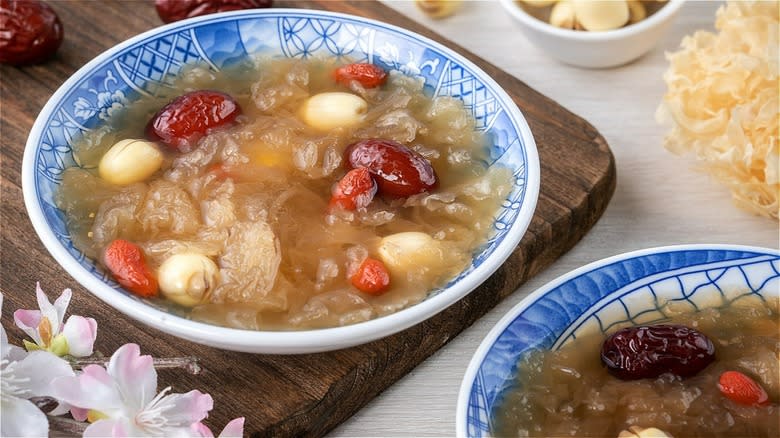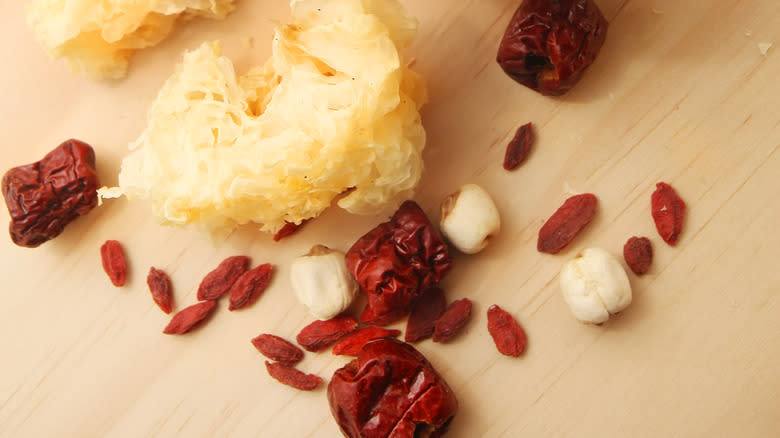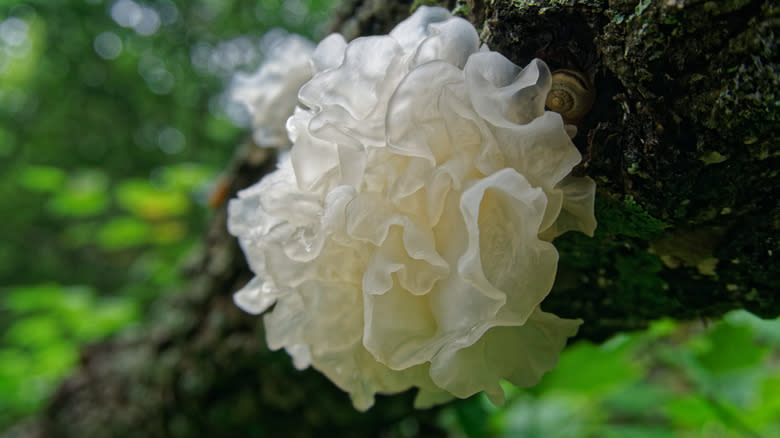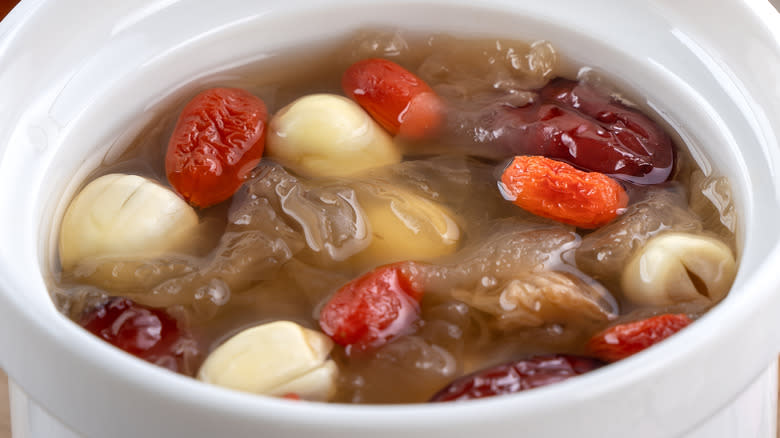Snow Fungus Soup Is The Chinese Dessert You Need To Try

While the Western world recognizes soup as warm, savory bowls of brothy comfort food, China is a fan of sweeter dessert soups that can be served cold. One such dish is snow fungus soup, a delicacy that has stuck around for centuries for its myriad medicinal benefits. The soup's main ingredient is an edible mushroom known scientifically as tremella fuciformis, which sometimes goes by other names like "snow mushroom" and "silver ear" based on its appearance. This translucent, jelly-like superfood grows mainly on tree bark throughout Asia and in other tropical regions around the world, but can be easily found in Asian grocery stores.
Snow fungus soup falls under the Cantonese umbrella term "tong sui," which literally means "sugar water," but it mostly refers to any type of soupy dessert, like China's classic red bean soup. Chinese New Year is one special occasion where snow fungus soup is served, and its flavor culturally represents sweet Chinese blessings. You'll even find tremella supplements sold today as fine-line reducers and hydrating skin products. The mushroom itself is pretty tasteless, but when you turn it into snow fungus soup, it becomes a sweet treat that only requires a few key ingredients to prepare.
Read more: 11 Unusual Dessert Combinations You Need To Try At Least Once
Recipe Variations For Snow Fungus Soup

The most basic recipe for Chinese snow fungus soup is vegan-friendly and free of gluten, and because the tremella mushroom tastes so bland on its own, the soup needs a few extra flavor bombs tossed in. This tong sui soup is one that plays heavily on various textures, so if you're someone who's afraid of mushrooms and their slightly slimy texture when cooked, it might not be for you. However, once you've added in the soup's other traditional ingredients that are a bit more solid, it could give your meal a more balanced mouth-feel. Typically, dried red dates, goji berries, and rock sugar are cooked with the dried snow fungus, but there are some recipes that use crunchy lotus seeds, ginkgo nuts, dried longans (similar to lychees), or cubed Asian pears, which give the soup a pleasantly fruity kick.
According to a study in Molecular Medicine Reports, snow fungus is rich in essential vitamins, minerals, and other beneficial nutrients, which is another reason why health-conscious eaters love this mushroom-based dish. The soup's ingredients play with flavor balance, like goji berries, which have a certain mouth-puckering tartness to them that is mellowed out by the rock sugar. If you're a fan of eating dates, you'll know about the tasty caramel aftertaste they have, which can give the soup a rich, natural sweetness when used in addition to sugar. The same goes for adding Asian pears to snow fungus soup for even more natural sweetness.
The History And Health Benefits Of Snow Fungus

Medicinal mushrooms like tremella were harvested by some of the world's earliest cultures, some dating as far back as 2,000 years. Snow fungus was specifically referenced in an early text of Traditional Chinese Medicine, written around 200 A.D. by Shen Nong ben Cao Jing who was known as the Father of Chinese medicine. One legend that seems to circulate widely in the beauty community tells of Yang Guifei, one of the emperor's favorite concubines during China's flourishing Tang Dynasty. It's said that she used snow fungus to retain her title as one of the nation's "Four Great Beauties," using it as a staple in her skincare regimen.
Once reserved for royals, tremella mushrooms are now commonly consumed or used topically throughout Asia. Aside from being chock-full of nutrients, the molecular structure of snow fungus allows for it to be easily absorbed into the skin when eaten. This rehydration superpower is the main reason why it dominates the world of Asian skincare not only in the form of wrinkle-reducing creams and masks, but supplements as well.
Besides being high in fiber and antioxidants, some studies suggest that this type of mushroom may also have immune-boosting properties during illness recovery, provide anti-inflammatory relief, and may contribute to healthy brain and organ function. It has also been used to clinically treat chest congestion and help regulate blood sugar levels.
How To Make Chinese Snow Fungus Soup

When purchasing dried snow fungus at your local Asian grocer, it's important to choose one with a yellowish tint to ensure it's high quality, as pure white could be a sign of bleaching. The time-consuming part of making homemade snow fungus soup is the rehydration process, which can take as little as one hour, but most recipes suggest around two to three hours or even overnight. Cold or room temperature water is recommended, since soaking the fungus in hot water will strip it of its crispness and nutrient content. Once it's softened and tripled in size, Chinese snow fungus needs to be trimmed to remove its hard, orange core before being torn into bite-sized pieces.
Now you can boil your rehydrated snow fungus in a pot of roughly 10 cups of water while you prep the goji berries, Asian pears, dates, and a few generous teaspoons of rock sugar to taste. If you prefer a little more crunch to your snow fungus, you'll boil it for around 15 minutes before adding the other ingredients. For a more gelatinous, syrupy dessert dish, you can boil the fungus for 30 minutes, followed by another half hour after the additional ingredients (except the goji berries) go in. Save the goji berries for the last five minutes of cooking so you don't end up with an overly sour soup. Enjoy it hot or refrigerate to try this Chinese cultural dish cold.
Read the original article on Mashed.

